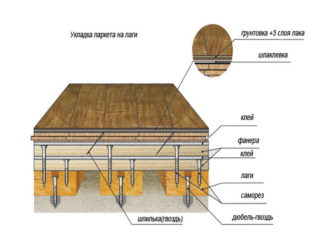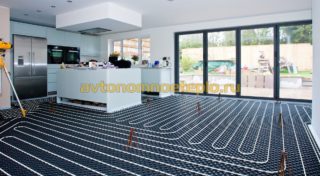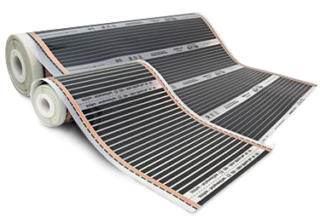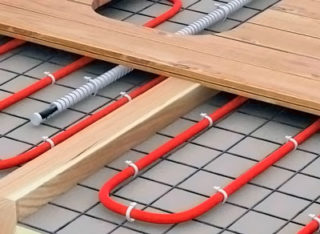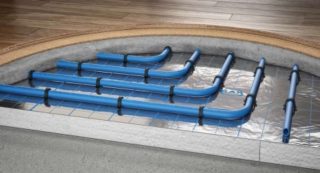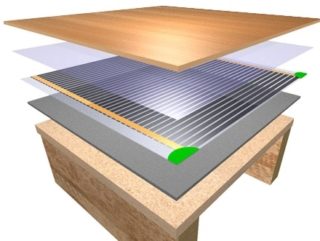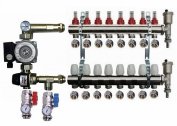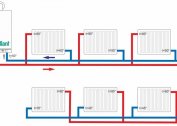Underfloor heating may not be used with all types of coatings. This is due to high temperature and humidity, which can lead to deformation of the material. Parquet board is made of wood, which is susceptible to moisture. For this reason, the installation rules must be observed.
Parquet and floor heating compatibility issues
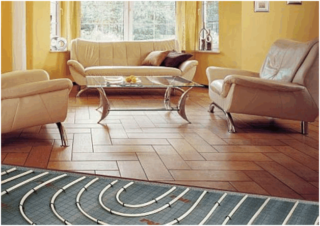
Parquet board is a good natural insulator that effectively protects against cold weather without the use of additional insulation materials. But in the case of additional floor heating, difficulties may arise. They are due to the following factors:
- Hypersensitivity to moisture and temperature. Exceeding the accepted norm can lead to deformation of the coating and the appearance of cracks.
- Installation of a parquet board for a warm floor is carried out on self-tapping screws. These fasteners can damage the pipes along which the coolant, electrical cable or thermal film moves. Violation of the integrity of these parts can lead to failure of the entire system.
To avoid these problems, you need to choose the right materials for the underfloor heating and do the installation according to the instructions.
Device recommendations
In the case of using decorative parquet, certain recommendations must be followed in order to guarantee the effectiveness of the warm floor without deformation and damage to the coating.
- Do not use maple or oak parquet under the warm floor. These tree species are deformed at the slightest change in temperature.
- The optimal thickness of parquet boards is 12-15 mm. When using thinner material, the risk of fracture increases and the strength of the material deteriorates. Thicker boards do not allow heat to pass through well, which is why the floor works inefficiently.
- Laying should be carried out in a floating manner. Thanks to this method, thermal movements will cause structural movements that will protect the material from destruction.
- The plywood for the substrate must be fixed to the concrete base using two-component polyurethane adhesive. To additionally fix the structure, self-tapping screws are used. First you need to make markings for their fastening.
- A layer of thermal insulation is placed on the surface of the plywood under the parquet. It reduces the temperature effect on the board, but at the same time worsens the effect of heating. Layer thickness should be minimal.
- The maximum heating temperature of the lower layer of parquet should not exceed 40 ° C. With these values, the room will have a comfortable temperature range of 27-28 ° C on the floor surface.
- Wooden planks are attached to metal staples. Thanks to them, you can make a connection without installing additional mechanisms. Also, this method allows you to naturally control the narrowing and expansion of the board during temperature jumps.
- Uniform heating of the entire surface of the floor covering must be ensured.
Strict adherence to the installation instructions will allow the underfloor heating to function during the declared period and not harm the parquet flooring.
Options for underfloor heating under parquet
There are several varieties of underfloor heating: water, thermal film and cable. In each design, the laying of the floor parquet will have its own characteristics.
Water heating
This type of floor heating is one of the most common. It implies the installation of pipes along which the coolant moves - hot water. Thermal energy is obtained from an existing heating system or various boilers.
In the case of a water floor, the heating circuit is laid by a snake, snail or other method. To fix the pipes, plastic ties are used, which are pre-fixed to the reinforcing mesh.
There are modern options for arranging floor heating, which imply the use of a heat-insulating substrate. This design has special protrusions in which the pipelines are laid.
The water floor has an important drawback - pipes must be laid in a thick layer of cement screed. The design will have a lot of weight, in case of breakage it will not be possible to repair.
It is important to test the pipes and check their performance before filling. The heating circuit should be made from a single piece of pipe without the use of connecting elements.
Film
Infrared warm film floor - a modern solution for heating a house. It has many advantages over other systems. When laying, the use of a cement-sand screed is not required, due to which a thin structure will be formed with minimal labor costs.
Installation of heating elements is carried out on a thin heat-insulating substrate with a foil coating. All elements should be connected in parallel with each other. The control of basic temperature characteristics is carried out using a temperature regulator.
The main advantages include:
- Flexibility. You can lay on non-standard surface shapes - podiums, ledges, steps.
- Ease of mounting and dismounting without changing the characteristics. The absence of a concrete screed will make it possible to repair failed elements without destroying the entire system.
- In case of failure of one of the sections, the entire system will continue to heat the room.
- Long service life.
- High heating rate. The boards heat up in about 10 minutes.
- Power saving
- Safety for human health.
The disadvantages include the high cost of flooring.
Cable system
A single-core or two-core cable is a heating element. They are placed on a heat-insulating substrate. Fixing is carried out due to special fasteners according to a certain pattern, the distance between which depends on the performance of floor heating.
Also available as heating mats. Their design consists of a grid on which cables are laid. It is easier to carry out installation with mats, since it is not necessary to calculate the distance between the turns of heating elements. The obligatory device in the system is the temperature controller. It monitors and changes the system parameters to create a comfortable room temperature.
Such heaters are enclosed in a screed layer. After installing the floorboard.
The cable system is the most energy-intensive. During operation, the charge for electric energy will increase.
Installation of underfloor heating under parquet
When using a water heated floor, the parquet laying algorithm is as follows:
- Installation of insulation on a concrete base. On one side there should be a heat-reflecting foil.
- Laying pipes with a spiral or a snake.
- Pouring cement-sand screed.
- 28 days after curing, plywood is fastened.
- Parquet is laid on a warm water floor.
This method is notable for the complexity of the work, so you need to entrust installation to a specialist.
Installation using cable floor:
- Concrete foundation preparation.It is necessary to remove the old coating and clean the surface.
- Installation of thermal insulation.
- Cable management
- Pouring cement-sand mortar.
- Laying the parquet after the screed has completely dried and cured.
Stages of laying a film IR floor:
- Foundation preparation. It can be concrete or wood.
- Laying waterproofing.
- Laying thermal insulation.
- Laying infrared film, which is fixed to the construction tape.
- Laying plywood to create a foundation.
- Installation of parquet boards.
It is also necessary to install a temperature controller.
Due to its characteristics, the infrared system is the best option in combination with parquet. Despite the ease of installation, parquet must be laid by a master who has experience with such systems.
